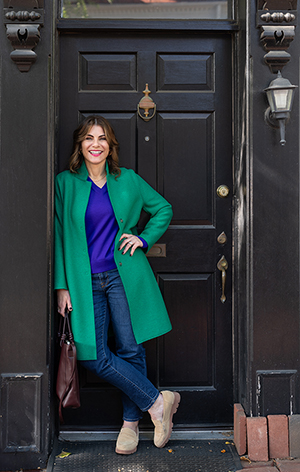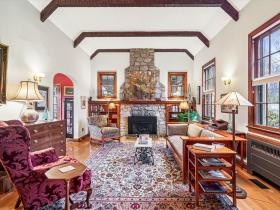 Trinidad: The Difference 5 Years Makes
Trinidad: The Difference 5 Years Makes
✉️ Want to forward this article? Click here.

To many in DC, Trinidad is unfortunately remembered for a conspicuous police presence that made headlines five years ago. A slew of gun violence in 2008 resulted in the police department taking the drastic step to set up checkpoints for drivers coming into the Northeast DC neighborhood to determine if they had a “legitimate purpose” for entering.
That scar has been slow to disappear, but a few years have made a difference in how the neighborhood is perceived. Trinidad’s location just to the north of the H Street Corridor coupled with (up until recently) an affordable housing market by DC standards, has made it an attractive destination for young adults, who join many residents that have been there for generations.
Now, as its popularity grows and housing prices rise, a determination has emerged to keep the area affordable and its character intact. New residents, who have seen the tensions created by gentrification in surrounding areas, are working to protect older residents from being pushed out.
DC’s Trapezoidal Neighborhood to the East
Trinidad is a trapezoidal neighborhood that is roughly bounded by West Virginia Avenue NE to the west, Mt. Olivet Road to the north, Bladensburg Road NE to the east and Florida Avenue NE to the south. As noted, it sits to the north of the bustling development in the H Street Corridor and several blocks east of DC’s newest destination, Union Market.
The neighborhood was reportedly named after a 19th century speculator who hailed from the more famous tropical Trinidad. Several houses were built in the area in the late 1800s, and for several decades, working and middle-class residents enjoyed a pleasant existence in the quiet, leafy neighborhood.
During the 1950s and 60s, suburbs started luring DC residents away. In 1968, riots ripped through the area and sped up the exodus. Then, a real estate scandal created the perfect environment for illicit activity: due to the unlucky fate of falling within the sights of unlawful speculators in the 1980s, many homes in the neighborhood were driven into foreclosure, laid vacant, and then were reborn as crackhouses. Trinidad became an open air drug market, and the crack epidemic of the 80s and 90s left severe scarring throughout the area. Only in the last several years has the neighborhood begun to turn a corner.
A Housing Bubble or Formerly Undervalued Homes?
Trinidad’s renaissance has gained momentum in the last five years, and the neighborhood has consequently seen real estate appreciation that, of late, has made even DC’s hot market look a little lukewarm.
UrbanTurf recently reported on a Trinidad home that increased in value by $165,000 in just two years, and two weeks ago, neighborhood blogger Titan of Trinidad featured a home that entered the market for almost $1 million, an unimaginable price point for the area just 12 months ago.
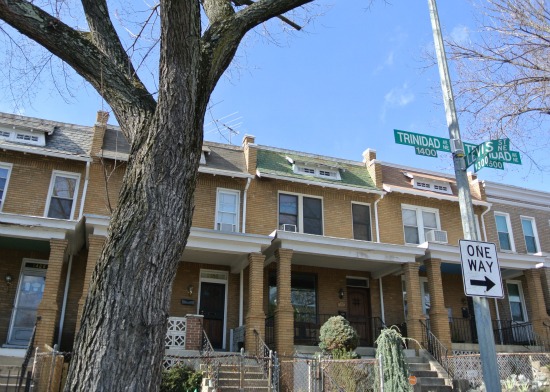
Row houses on Trinidad Avenue.
Kyle Stearns, who zeroed in on buying in Trinidad after attending the H Street Festival, has experienced the high prices and heated competition associated with the Trinidad market. Stearns and his fiance have been searching for a family-sized row house in the $400,000 range for a few months. They found two homes that they liked, but after two unsuccessful offers, they are getting discouraged. “For each house, we offered between $30,000 and $50,000 over the asking price, and there were at least eight competing offers on each,” said Stearns, who thinks there is a mini housing bubble in the neighborhood.
Real estate agent Jennifer Myers thinks differently.
“A bubble assumes a burst or pop,” said Myers. “I don’t think that’s happening in Trinidad. The area has been undervalued for so long, it’s finally catching up to where it should be and prices will rise to a point and remain steady. It’s the natural progression that H Street had after Capitol Hill, and it’s only logical to think that Trinidad is next.”
Can Affordable Housing Be Maintained?
According to Keller Williams’ Suzanne Des Marais, 85 fee simple homes sold in Trinidad last year at a median price of $242,500, with a range from $103,575 to $550,000. (Des Marais’ analysis covered the legal subdivision of Trinidad, which also includes several blocks to the east of Bladensburg Road.) Compare those numbers to 2010 when 96 fee simple homes sold, but the median price was much lower ($179,503), and the highest priced sale was just $409,090. The difference in price for the highest priced condo sale in each of those years shows an even greater difference: $309,118 in 2010 compared to $510,000 in 2012.
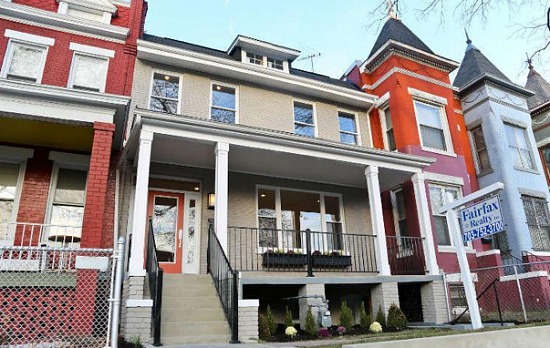
The almost $1 million house for sale.
The rising prices have long-time residents like Marqui Lyons worried. “Increased property taxes will be hard on older residents,” Lyons told UrbanTurf. “The city as a whole needs to address that.”
In addition to rising home prices, new apartment projects are driving up rental rates. When The Flats at Atlas, an apartment complex with monthly rents ranging from around $1,700 to $3,000, delivered about a year ago on Bladensburg Road, some residents took a concerned look at the project.
“A lot of people had questions,” said Jaime Fearer, a resident and Secretary of the Trinidad Neighborhood Association. “Does that mean we’re getting kicked out? Does that mean I won’t be able to afford a place to live?”
As vacant homes get snapped up by newcomers or developers, many houses are changing hands as residents “age out.” Fearer and her husband bought their home in an estate sale a few years ago after the previous resident passed away. More transformative, said Fearer, are apartment buildings that are being bought by developers, renovated, and then sold as higher-end condos.
“When a four-unit building gets gutted and goes on the market as condos, you’ve lost affordable units,” noted Fearer. ““We have to work proactively now to preserve affordability.”
Certain measures are being taken. Last fall, the American Planning Association embarked on a pro bono effort to connect Trinidad residents with urban planners who could help them brainstorm strategies on how to maintain affordable housing while welcoming economic development. In 2011, the DC Department of Housing and Community Development and the National Community Reinvestment Coalition, funded by HUD, launched an initiative to create a strategy to do the same. In addition to meeting with the community, they also conducted market research and examined strategies such as workforce training and worker-owned business co-ops. DHCD is planning on investing $9.5 million in property acquisition, home rehabilitation and home purchase assistance in Deanwood, Anacostia, Ivy City and Trinidad, according to the initiative site.
Whether any of these efforts can counter the rising tide of home prices in the neighborhood remains to be seen.

Joseph H. Cole Recreation Center
The New and The Old
When Fearer and her husband moved in to their row house a few years ago, they made a point to reach out to residents in the surrounding houses and now have strong neighborly relationships. “I have found in this neighborhood, if you are able to look someone in the eye, say “Hi, how are you doing?’ and be sincere, it goes a long way,” she said. Comments from happy new residents in an article about the neighborhood that UrbanTurf published in 2010 seem to largely echo that sentiment.
Of course, like any neighborhood that is being populated by a younger web-savvy generation, Trinidad now has a fairly active blog presence. Frozen Tropics has covered the area surrounding the H Street Corridor, including Trinidad and north Capitol Hill, for a few years and Titan of Trindad (ToT) has established itself as a dependable voice in the last several months.
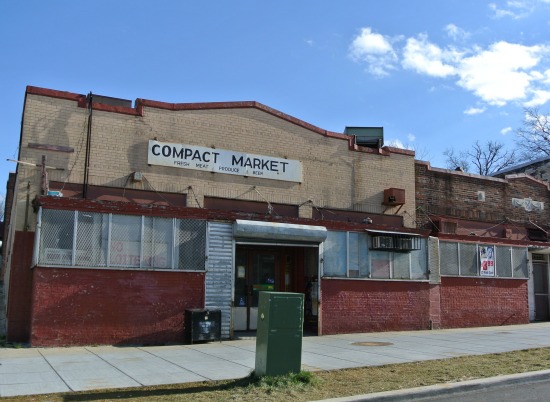
A market on Montello Avenue.
Initially irreverent and parody-esque with posts about dingy storefronts and graffiti written in a satirically enthusiastic manner, ToT has become more serious and investigative in recent months, reporting on real estate, schools and new developments as well as breaking news about shootings, drug busts, and the criminal endeavors of local politicians.
Fearer, who is responsible for the web presence of the neighborhood association, maintains a website, Twitter feed and Facebook page.
A Hard-to-Change Reputation
Thirty years ago, Trinidad was one of DC’s centers for drug-related activity and associated violence. The 2008 incident, referenced above, perhaps unfairly bolstered that reputation in many people’s minds.
While crime has dropped since then, a look at recent statistics reveals a slew of robberies, some armed, in the last month, as well as a couple shootings. The crime is distributed throughout the neighborhood, but the northwest corner is particularly active, while the south end is relatively peaceful.
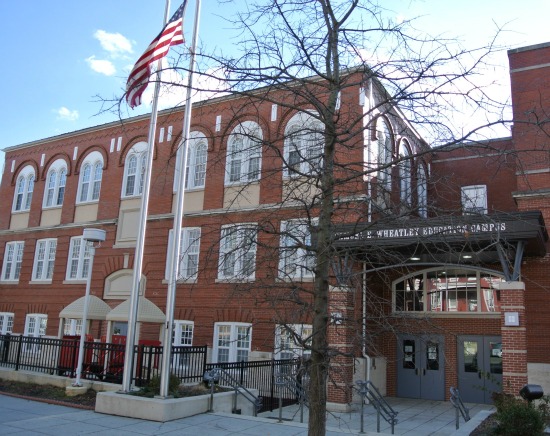
Wheatley Education Campus
However, in conversations that UrbanTurf had with a number of current residents, most spoke to how safe the area now feels. With its sizable population of long-time residents, a culture of looking-out-for-the-neighbors exists, and new residents who interact with their older ones can tap into it. “I feel quite safe where I live,” said Frozen Tropics author Elise Bernard, who has lived on the south side of the neighborhood for ten years. “Neighbors tend to watch out for each other.”
Litter, on the other hand, is one of residents’ biggest concerns. The environment created by a trash-filled street leads to certain “issues,” Fearer politely hinted. One of our recent commenters was more explicit. “It’s still rodent-infested,” said the former resident, who moved out in 2010.
Schools and Two Rec Centers
The neighborhood has several pre-kindergarten through eighth grade schools within its bounds, including the Wheatley Education Campus, a public school on Neal Street, and the Center City PCS Trinidad Campus, a charter school on West Virginia Avenue. Webb Elementary School closed in 2009, but KIPP, the national charter school network, recently announced plans to take over the space in the near future. Trinidad also has two recreational centers — Trinidad Recreation Center and the Joseph Cole Recreation Center.
Aside from the amenities on the H Street Corridor, residents have access to the retail on Bladensburg Road, though it seems dominated by liquor stores and auto shops. However, the owner of Bardo Rodeo, a popular, shuttered Arlington brewpub, is opening a new project at 1200 Bladensburg Road. The founder plans to resurrect Bardo, using the same brewing equipment and recipes.
The Bottom Line
Its location and solid housing stock are drawing people to Trinidad, but it also making a once affordable neighborhood less so. In the coming years, we’ll see if the steamroller of development yields at all to residents trying to maintain affordable housing options.
Similar Posts
This article originally published at https://dc.urbanturf.com/articles/blog/trinidad_the_difference_5_years_makes/6591.
Most Popular... This Week • Last 30 Days • Ever

With frigid weather hitting the region, these tips are important for homeowners to ke... read »

Today, UrbanTurf offers a brief explanation of what it means to lock in an interest r... read »

A new report from DC’s Office of Revenue Analysis highlights how millennials and wo... read »

The 30,000 square-foot home along the Potomac River sold at auction on Thursday night... read »

An application extending approval of Friendship Center, a 310-unit development along ... read »
DC Real Estate Guides
Short guides to navigating the DC-area real estate market
We've collected all our helpful guides for buying, selling and renting in and around Washington, DC in one place. Start browsing below!
First-Timer Primers
Intro guides for first-time home buyers
Unique Spaces
Awesome and unusual real estate from across the DC Metro

